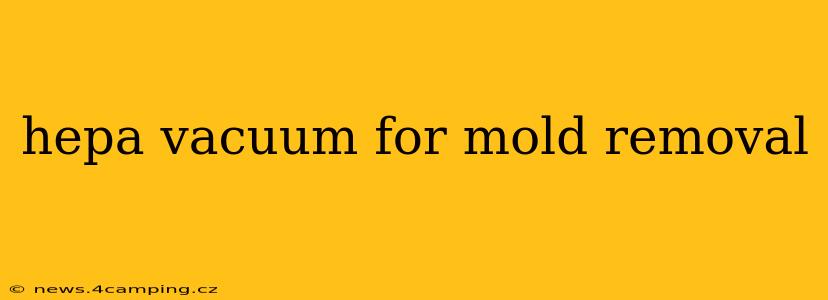Mold in your home is a serious issue, impacting both your health and the structural integrity of your property. While professional mold remediation is often necessary for extensive infestations, a HEPA vacuum cleaner can be an invaluable tool in the cleanup process, particularly for smaller areas or as part of a post-remediation strategy. This guide will delve into the importance of HEPA vacuums for mold removal, helping you understand how to choose the right one and use it effectively.
What is a HEPA Vacuum and Why is it Important for Mold Removal?
A HEPA vacuum cleaner is equipped with a High-Efficiency Particulate Air (HEPA) filter. This filter is designed to trap at least 99.97% of airborne particles with a size of 0.3 microns or larger. Mold spores are microscopic, falling well within this range. Regular vacuum cleaners often allow these spores to escape back into the air, potentially worsening the problem and exposing you to harmful allergens. A HEPA vacuum, however, significantly minimizes this risk, preventing the recirculation of mold spores and contributing to a safer cleaning environment.
What are the Key Features to Look for in a HEPA Vacuum for Mold Removal?
Choosing the right HEPA vacuum for mold removal requires careful consideration of several key features:
- HEPA Filtration: This is paramount. Ensure the vacuum explicitly states it has a true HEPA filter, not just a "HEPA-type" filter which may have lower efficiency.
- Sealed System: A properly sealed vacuum prevents air from leaking around the filter or motor, ensuring that all air passes through the HEPA filter. Look for vacuums specifically designed for allergen removal.
- Suction Power: Strong suction is crucial for effectively removing mold spores from surfaces and carpets. Consider the type of surfaces you'll be cleaning (hard floors, carpets, upholstery) when evaluating suction power.
- Portability: Depending on the size of the affected area, portability can be a key factor. Consider a lightweight model with a long cord or a cordless option for easy maneuverability.
- Attachments: Different attachments are essential for cleaning various surfaces. Look for crevice tools, upholstery brushes, and dusting brushes to ensure thorough cleaning.
- Filter Replacement: Check the ease of filter replacement and the cost of replacement filters. HEPA filters need regular replacement to maintain their effectiveness.
How to Use a HEPA Vacuum for Mold Removal Effectively?
Using a HEPA vacuum effectively involves more than just running it over the affected area. Here's a step-by-step approach:
- Preparation: Before vacuuming, wear appropriate personal protective equipment (PPE), including an N95 respirator, gloves, and eye protection. This protects you from inhaling mold spores. Isolate the affected area as much as possible to prevent the spread of spores.
- Vacuuming: Begin vacuuming from the cleanest area and work your way towards the most heavily affected area to avoid spreading contamination. Use the appropriate attachments for different surfaces. Work slowly and methodically, ensuring complete coverage.
- Filter Disposal: Once finished, carefully dispose of the HEPA filter according to the manufacturer's instructions. Moldy filters should be sealed in a plastic bag before disposal.
- Post-Vacuuming: Thoroughly clean all surfaces with an appropriate mold-killing solution (after vacuuming, not before).
Can a HEPA Vacuum Completely Remove Mold?
No. A HEPA vacuum is a valuable tool in mold removal, but it’s not a complete solution on its own. It removes surface mold and spores, but it doesn't address the underlying cause of the mold growth or penetrate porous materials where mold may be deeply embedded. For extensive mold infestations, professional mold remediation is absolutely essential.
When Should I Call a Professional Mold Remediation Specialist?
You should contact a professional mold remediation specialist if:
- You have a large area of mold infestation.
- The mold is growing behind walls or in hidden areas.
- The mold is affecting structural materials.
- You have health concerns related to mold exposure.
- You're unsure of how to handle the situation.
What are the Best Practices for Preventing Mold Growth?
Preventing mold growth is crucial. Here are some best practices:
- Control Humidity: Keep indoor humidity below 50%.
- Proper Ventilation: Ensure good ventilation in bathrooms, kitchens, and other moisture-prone areas.
- Promptly Address Leaks: Repair any leaks or water damage immediately.
- Regular Cleaning: Regularly clean and dry surfaces to prevent mold spores from settling and growing.
By understanding the role of a HEPA vacuum cleaner and following these guidelines, you can significantly reduce mold spores and contribute to a healthier living environment. Remember, however, that a HEPA vacuum is a tool to assist in cleaning, not a complete solution for serious mold infestations. Always prioritize your health and seek professional help when necessary.
